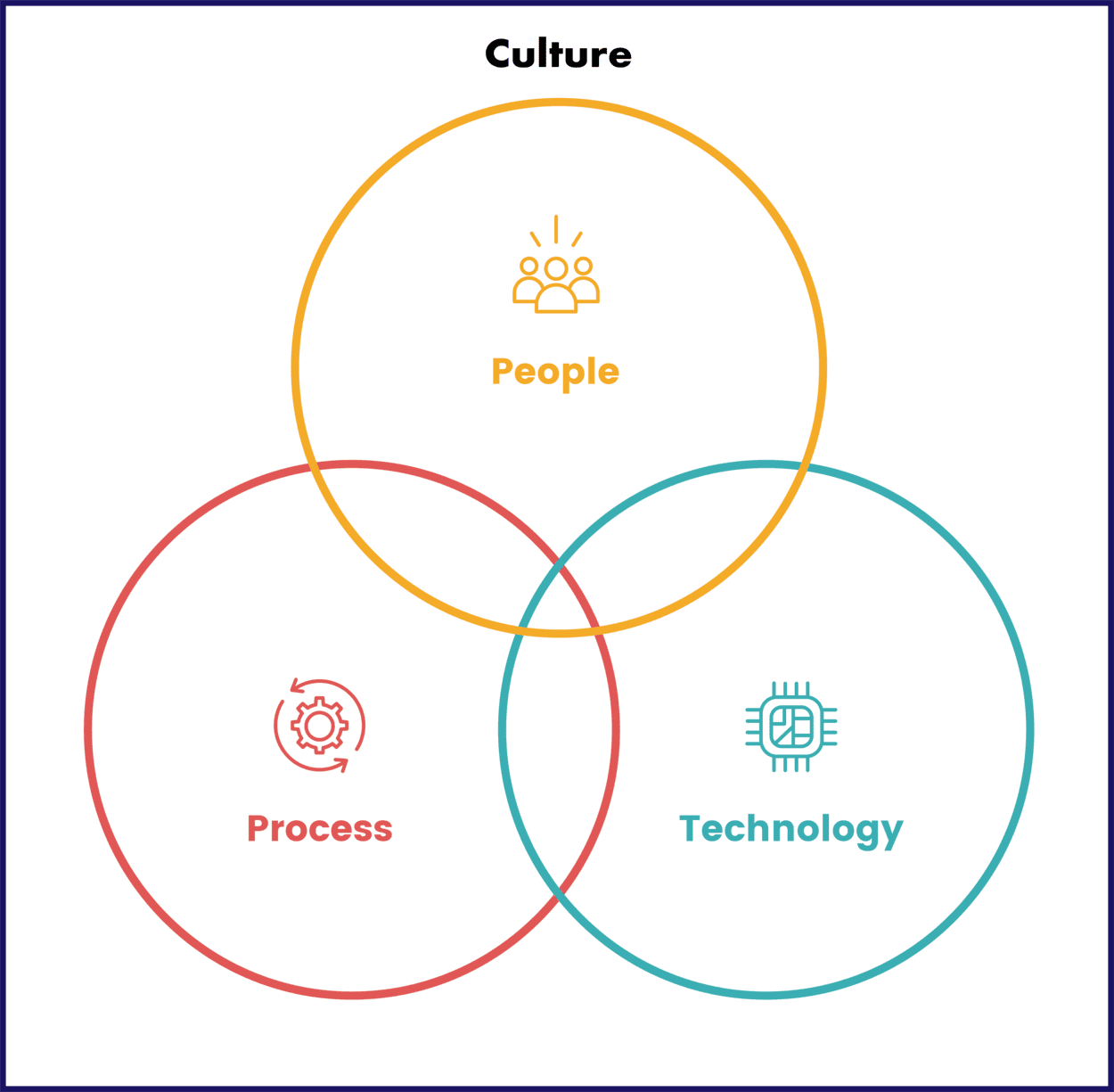Around 60 years ago, business management expert Harold Leavett developed the origins of what became the People, Process, Technology (PPT) framework. The three-part Venn diagram was used to show that if one of the parts changed, the other parts would most likely be affected. The PPT model can be applied to any system - the three parts are:
- People - those in the system that follow the systems processes using the technology made available to them. As the system processes and technology changes, the interactions will mean that people with different skills and competencies may be needed through either training and development or recruitment.
- Processes - the series of actions or steps taken by people using the technology available to them. Over time and as technology changes, manual processes may be automated, simplified, or disposed, and new processes may be needed. Any such process change will require people to adapt, often through training and development.
- Technology - the tools or technologies available for use. In terms of complexity, at one end of the scale a new technology may something as simple as a cordless screwdriver, and at the other and an artificial intelligence (AI) tool that optimises the distribution of resources to meet the customer requirements of a global supply chain logistics provider. Changes in technology are often the driving force behind disruptive and transformational changes around which whole new systems are created. Deploying and operating the new systems place new demands on people who may need to develop completely new skill sets. When automation or semi-automation of processes is an outcome, new processes may need to be created by starting with a blank page.
The PPT model has lasted the test of time. Its simplicity and the clear logic mean it can be picked up and adapted to almost any system change scenario and used as a tool to undertake any combination of the following:
- Systems definition, analysis, deployment and operation.
- Process change
- Technology selection
- People development and training
However, making change in the real world is not something that can be captured from a perspective that looks at the interaction of just people, processes, and technology, especially when it comes to making change that touches or involves the most variable part of the system, that of people.
Culture is the missing component. Sometimes described as ‘the way we work around here’, culture influences how people interact, communicate and make decisions. Looking beyond the high-level statements about organisational values, what happens in the workplace is influenced by the very personal experiences of each employee in their working environments and these will affect their engagement, productivity, performance, and wellbeing.
Recognising this as an important factor - if not the most important, the new and unique Interimconsult system model is based on adding a fourth component - culture - within in which people, processes, and technology interact. Its impact is clear - we have all had experiences where what appear to be common-sense changes in processes or the adoption of new technology, are progressed or held back based on an influencer's behaviours. Change is not just about changing the interaction of people, process, and technology, making every change initiative unique.
The PPTC Model
The recognition of culture as a contributing factor to systems and therefore systems change is the driving force behind the development of the new Interimconsult PPTC model - People, Process, Technology and Culture.
Rather than a definition of culture based on ambiguous statements about missions, visions, values, etc., this new system component can be described in terms of how it is expressed through behaviours.
- Culture - the ways people interact and behave in different situations, remotely and in one-to-one and one-to-many engagements involving leaders, managers, peers, and other staff. This adaptation recognises that the interactions and behaviours of decision makers and those with authority and influence can accelerate or slow-down change initiatives based on either an individual’s or collective’s reactions to planned and unplanned changes.
The significance of adding culture to the model is that in doing so, different interventions can be identified to trigger system change. The interventions might focus on issues such as communication, messaging, the way in which change is managed, and the development of positive collective behaviours.

Figure 1. The new system model shows the PPT components at the centre, embedded within the culture, emphasising its importance when it comes to making system change.
So What?
- Industries, organisations, and teams are complex systems that are continuously changing, and culture plays a part.
- Although the People, Process, Technology (PPT) framework helps understand the interactions between its different components, it does not take into account the impact of culture in making system change - whereas the new PPTC model recognises it as a key feature.
- The new PPTC model considers culture from the perspective of the ways people interact and behave in different work situations. It can be used to identify the interventions needed to create sustainable culture and system change.




